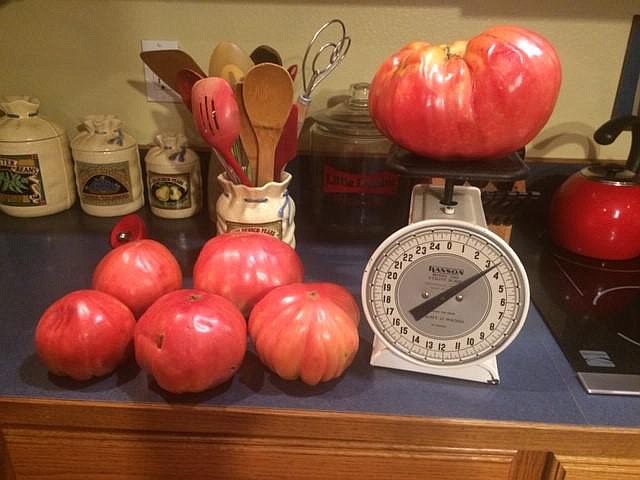Q. Look at this giant tomato we grew in Centertown! It weighs 3 pounds, 4 ounces and is from a German heirloom tomato (quite similar to Oxheart).
A. Whoa, Nelly! That's a big one. With our September summer weather coming to an end, it will be impressive if a yet bigger tomato surfaces in the Jeff City area. Thanks for sharing.
Q. I have a caterpillar munching off all the leaves of an oak tree. Since it is so late in the year, do I need to be concerned?
A. Most likely not. Mid- to late-season caterpillars such as mimosa webworm, orange-striped oakworm, fall webworm, etc., generally do not require control except on young trees or if heavy defoliation is occurring. As we are in October, I would even have less concern. I would protect a small tree in August through mid-September. Products containing BT (Bacillus thuringiensis) such as Dipel or Thuricide would work well if you need control. They are selective in controlling mostly caterpillars and not harming other insects.
Q. I have too many violets in my lawn. Is there an herbicide I can use to get rid of them?
A. Ortho Weed B Gon Chickweed, Clover & Oxalis Killer for Lawns states on its label it controls violets. You should be able to find it at some local retailers. The active ingredient is triclopyr, which is pretty potent, so pay special attention to warning on when to use, how and what plants to stay away from when applying. You may be able to find other product manufacturers of 'triclopyr' labeled for controlling violets in lawns.
Q. I am getting these big, tan rot spots on my apples this year. What are they? Can I do something to control them next year? I don't remember them occurring before.
A. The symptoms you describe are consistent with black rot (of the apple fruit), which when on the leaves is called "frogeye leaf spot." I also have it on my golden delicious apples. The disease is aggravated by rainy weather in late summer. If we don't have those regular rains, it generally isn't a problem. Another disease on apples is also favored by rainy weather in late summer, "sooty blotch." Both can be controlled by applying the fungicide 'Captan' two or three times through late summer. But most folks don't think to do this, as how do you know we'll end up with enough of those rainy spells to trigger the disease? Some cultivars are more prone to these diseases and could be sprayed if black rot occurs too often. For future summers, you could scout the leaves occasionally and if you see any frogeye leaf spot symptoms in July or August, then apply Captan a couple of times two to three weeks apart.
Q. OMG, September was hot! Any tidbits on how bad it was?
A. For Missouri, besides being the hottest September since 1897 and the second hottest ever, here's another. Using a single weather station on University of Missouri's campus (Sanborn Field), September was (narrowly) hotter than August. The average daily temperature across all of September was 75.70 F, in August it was 75.60 F. The average high temperature across September was 85.40 and 84.60 for August. It is quite uncommon for this to occur, but then August was a tad on the mild side for Missouri this year.

